 Kawasaki J300 - Service manual > Charging System
Kawasaki J300 - Service manual > Charging System
Alternator Cover Removal
- Drain:
Engine Oil (see Engine Oil Change in the Periodic Maintenance chapter)
Coolant (see Coolant Change in the Periodic Maintenance chapter) - Remove:
Storage Box (see Storage Box Removal in the Frame chapter)
Lower Fairing (see Lower Fairing Removal In the Frame chapter)
Exhaust Pipe (see Exhaust Pipe Removal in the Engine Top End chapter) - Remove the band [A] and slide the dust cover [B].
- Open the clamp [C].
- Disconnect:
Crankshaft Sensor Lead Connector [D]
Alternator Lead Connector [E]
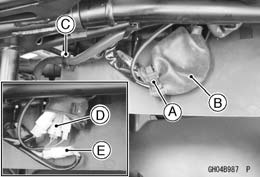
- Open the water hose clamp and disconnect the water bypass hose [A].
- Loosen the water hose clamp screws and disconnect the water hoses [B].
- Remove:
Alternator Cover Bolts [C]
Clamps [D]
Alternator Cover [E]
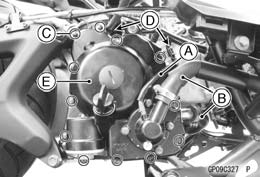
Alternator Cover Installation
- Using a high flash-point solvent, clean off any oil or dirt that may be on the liquid gasket coating area. Dry them with a clean cloth.
- Apply liquid gasket to the alternator lead grommet [A] on the alternator
cover.
Sealant - Liquid Gasket, TB1211F: 92104-0004
- Replace the O-rings [B] with new ones.
- Apply grease to the new O-rings.
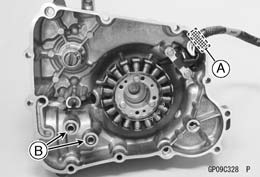
- Check that the dowel pins [A] are in place on the crankcase.
- Replace the alternator cover gasket with a new one. -
- Tighten the alternator cover bolts together with the clamps.
Torque - Alternator Cover Bolts: 9.8 N*m (1.0 kgf*m, 87 in*lb)
- Run the lead and water hoses correctly (see Cable, Wire, and Hose Routing section in the Appendix chapter).
- Tighten:
Torque - Water Hose Clamp Screws: 4.4 N*m (0.45 kgf*m, 39 in*lb) - Install the removed parts (see appropriate chapters).
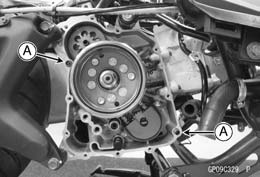
Stator Coil Removal
- Remove:
Alternator Cover (see Alternator Cover Removal)
Crankshaft Sensor Bolts [A]
Crankshaft Sensor [B]
Alternator Lead Grommet [C]
Stator Coil Bolts [D] - Remove the stator coil [E] from the alternator cover.
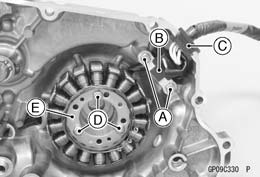
Stator Coil Installation
- Install the stator coil and crankshaft sensor, and tighten them bolts.
Torque -
Stator Coil Bolts: 9.8 N*m (1.0 kgf*m, 87 in*lb)
Crankshaft Sensor Bolts: 4.4 N*m (0.45 kgf*m, 39 in*lb) - Using a high flash-point solvent, clean off any oil or dirt that may be on the liquid gasket coating area. Dry them with a clean cloth.
- Apply liquid gasket to the circumference of the alternator lead grommet,
and fit the grommet into the notch of the cover securely.
Sealant - Liquid Gasket, TB1211F: 92104-0004
- Install the alternator cover (see Alternator Cover Installation).
Alternator Rotor Removal
- Remove the alternator cover (see Alternator Cover Removal).
- Hold the alternator rotor steady with the flywheel holder [A], and
remove the rotor nut [B] and washer.
Special Tool - Flywheel Holder: 57001-1313
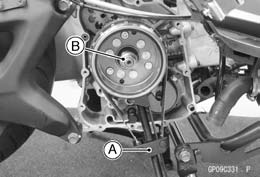
NOTICE Do not hold the rotor at pick-up portion with the flywheel holder.
- Using the flywheel puller [A] and rotor puller [B], remove the
alternator rotor from the crankshaft.
Special Tools -
Rotor Puller M18 × 1.5, M16 × 1.5: 57001 -1099
Flywheel Puller, M28 × 1.0: 57001-1471
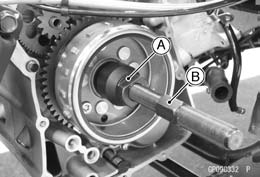
NOTICE Do not attempt to strike the alternator rotor itself.
Striking the rotor can cause the magnets to lose their magnetism.
Alternator Rotor Installation
- Remove the starter motor [A] temporary (see Starter Motor Removal).
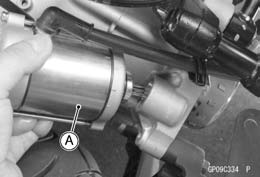
- Using a cleaning fluid, clean off any oil or dirt on the following
portions and dry them with a clean cloth.
Crankshaft Tapered Portion [A]
Alternator Rotor Tapered Portion [B] - Fit the woodruff key [C] securely in the slot of the crankshaft.
- Align the woodruff key on the crankshaft with groove [D] on the alternator rotor.
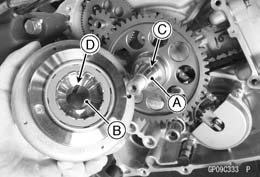
- Push the alternator rotor while turning the starter motor clutch gear [A] counterclockwise until it engaged into the starter clutch case.
- Install the starter motor (see Starter Motor Installation).
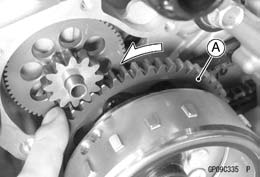
- Install the washer and rotor nut [A].
- Tighten the alternator rotor bolt while holding the alternator rotor
steadily with the flywheel holder [B].
Special Tool - Flywheel Holder: 57001-1313
Torque - Alternator Rotor Nut: 59 N*m (6.0 kgf*m, 44 ft*lb)
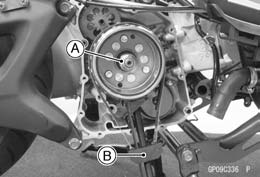
NOTICE Do not hold the rotor at pick-up portion with the flywheel holder.
- Install the alternator cover (see Alternator Cover Installation).
Charging Voltage Inspection
- Check the battery condition (see Charging Condition Inspection).
- Warm up the engine to obtain actual alternator operating conditions.
- Remove the battery case cover (see Battery Removal).
- Check that the ignition switch is turned off, and connect a digital meter [A] to the battery terminals [B].
- Start the engine, and note the voltage readings at various engine speeds with the headlight turned on and then turned off (To turn off the headlight, disconnect the headlight connector.). The readings should show nearly battery voltage when the engine speed is low, and, as the engine speed rises, the readings should also rise. But they must be kept under the specified voltage.
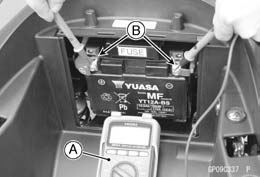
Charging Voltage

- Turn off the ignition switch to stop the engine, and disconnect the
digital meter.
If the charging voltage is kept between the values given in the table, the charging system is considered to be working normally.
If the charging voltage is much higher than the values specified in the table, the regulator/rectifier is defective or the regulator/rectifier leads are loose or open.
If the charging voltage does not rise as the engine speed increases, then the regulator/rectifier is defective or the alternator output is insufficient for the loads. Check the alternator and regulator/rectifier to determine which part is defective.
Alternator Inspection
There are three types of alternator failures: short, open (wire burned out), or loss in rotor magnetism. A short or open in one of the coil wires will result in either a low output, or no output at all. A loss in rotor magnetism, which may be caused by dropping or hitting the alternator, by leaving it near an electromagnetic field, or just by aging, will result in low output.
- To check the alternator output voltage, do the following procedures.
- Turn the ignition switch off.
- Remove the storage box (see Storage Box Removal in the Frame chapter).
- Remove the band [A] and slide the dust cover [B].
- Disconnect the alternator lead connector [C].
- Connect a tester as shown in the table 1.
- Start the engine.
- Run it at the rpm given in the table 1.
- Note the voltage readings (total 3 measurements).
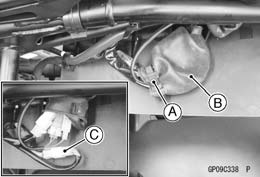
Table 1 Alternator Output Voltage @4 800 - 5 200 r/min (rpm)

If the output voltage shows the value in the table, the alternator operates properly. The regulator/rectifier is damaged.
If the output voltage shows a much lower reading than that given in the table, stop the engine and inspect the stator coil resistance.
- Check the stator coil resistance as follows.
- Stop the engine.
- Connect the tester as shown in the table 2.
- Note the readings (total 3 measurements).
Table 2 Stator Coil Resistance @20ºC (68ºF)

If there is more resistance than shown in the table, or no tester reading (infinity) for any two leads, the stator has an open lead and must be replaced. Much less than this resistance means the stator is shorted, and must be replaced.
- Measure the resistance between each of the Y leads and chassis ground.
Any hand tester reading less than infinity (∞) indicates a short, necessitating stator replacement.
If the stator coil has normal resistance, but the voltage check showed the alternator to be defective; then the rotor magnets have probably weakened, and the rotor must be replaced.
Regulator/Rectifier Removal
- Remove the rear fairing (see Rear Fairing Removal in the Frame chapter).
- Remove the band [A] and slide the dust cover [B].
- Disconnect the regulator/rectifier lead connector [C].
- Remove the band [D].
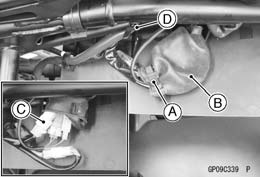
- Remove:
Regulator/Rectifier Nuts [A]
Aluminum Plate [B]
Regulator/Rectifier [C]
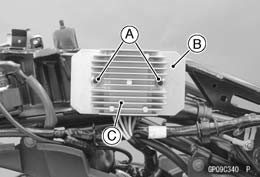
Regulator/Rectifier Installation
- Installation is the reverse of removal.
Charging System Troubleshooting
- Before inspection, remove all accessories that consume electrical power.
NOTE
- Even when the charging system is working properly, the battery may discharge if the motorcycle is equipped with too many accessories.
- Pay attention to riding conditions and the customer's riding habits which could affect the charging system such as:
Frequent use at low engine speed → Battery discharged Frequent and unnecessary brake pedal dragging → Battery discharged
- Recharge the battery if it is discharged.
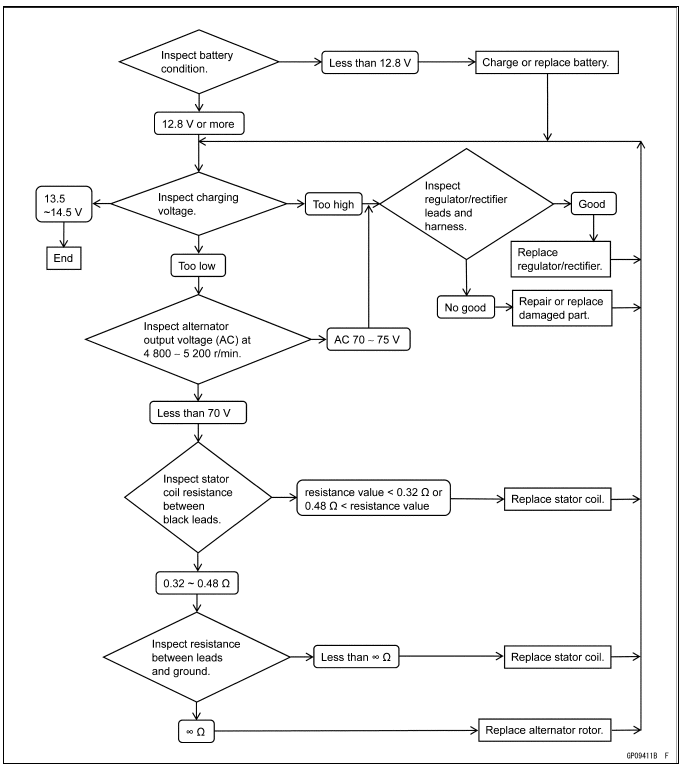
Charging System Circuit
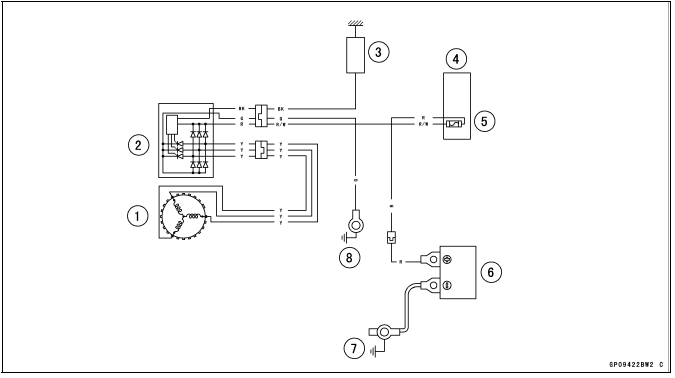
- Alternator
- Regulator/Rectifier
- Load
- Fuse Box
- Charging/ECU Fuse 30 A
- Battery 12 V 10 Ah
- Engine Ground
- Frame Ground 1
See also:
 Kawasaki J300 - Service manual > Battery
Kawasaki J300 - Service manual > Battery
Battery Removal Turn the ignition switch off. Open the seat. Remove: Screws [A] Battery Cover [B] Remove: Bolts [A] Battery Case Cover [B] Slide the red cap [A]. Disconnect the negative (-) cable [B] and then positive (+) cable [C].
 Kawasaki J300 - Service manual > Ignition System
Kawasaki J300 - Service manual > Ignition System
WARNING The ignition system produces extremely high voltage. Do not touch the spark plug, ignition coil or ignition coil lead while the engine is running, or you could receive a severe electrical shock.







